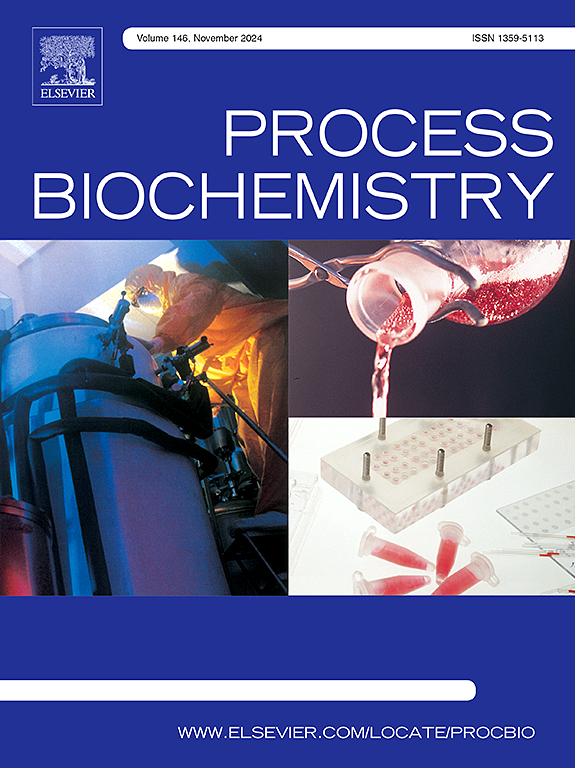从生物可再生植物甾醇中高水平生产谷内酯的运气分枝杆菌代谢工程
IF 4
3区 生物学
Q2 BIOCHEMISTRY & MOLECULAR BIOLOGY
引用次数: 0
摘要
近年来类固醇药物合成的进展越来越集中于利用从植物甾醇中提取的生物合成中间体,这是一种经济而丰富的微生物代谢原料。谷内酯(3aα-H-4α-(3 ' -丙酸)-5α-羟基-7aβ-甲基六氢-1-吲哚酮-Δ-lactone,或HIL)是合成类固醇药物的关键前体,特别是那些没有甲基或在C-10位置以α-甲基代替β-甲基的药物。在初步研究中,我们通过灭活福氏分枝杆菌ATCC 6842中的CAR1、CAR2和FadE30基因,获得了纯度仅为63.9 %的HIL。为了解决副产物的积累问题,我们随后鉴定并灭活了FadE30的三种同工酶(FadE31, FadE32, FadE33),导致HIL纯度超过99 %。优化后的菌株能够在72 小时内将10 g/L的植物甾醇转化为4.84 g/L的HIL,摩尔产量达到90.2 %,这是迄今为止报道的最高产量。当植物甾醇浓度为50 g/L时,时空效率最高,为3.66 g/L/d,摩尔产率为81.87 %,为历史最高产率。这些发现为制药生产中生产19-去甾体中间体提供了一种经济有效的方法,同时为类固醇核代谢提供了宝贵的见解。本文章由计算机程序翻译,如有差异,请以英文原文为准。
Metabolic engineering of Mycobacterium fortuitum for high-level production of sitolactone from biorenewable phytosterols
Recent advances in steroid drug synthesis have increasingly focused on leveraging biosynthetic intermediates derived from phytosterols, an economical and abundant raw material for microbial metabolism. Sitolactone (3aα-H-4α-(3’-Propionic acid)-5α-hydroxy-7aβ-methylhexahydro-1-indanone-Δ-lactone, or HIL) serves as a key precursor for the synthesis of steroid drugs, particularly those either devoid of a methyl group or featuring an α-methyl group instead of a β-methyl group at the C-10 position. In preliminary investigations, we achieved HIL production with a purity of only 63.9 % through the inactivation of the CAR1, CAR2, and FadE30 genes in Mycobacterium fortuitum ATCC 6842. To address the accumulation of by-products, we subsequently identified and inactivated three isoenzymes of FadE30 (FadE31, FadE32, FadE33), leading to an HIL purity exceeded 99 %. The optimized strain demonstrated the ability to convert 10 g/L of phytosterols into 4.84 g/L of HIL within 72 hours, achieving a molar yield of 90.2 %—the highest reported yield to date. Bioconversion experiments using phytosterol concentrations at 50 g/L yielded a maximum space-time productivity of 3.66 g/L/d with an 81.87 % molar yield, marks the highest yield recorded. These findings provide a cost-effective and efficient method for producing 19-norsteroid intermediates in pharmaceutical manufacturing while contributing valuable insights into steroid nucleus metabolism.
求助全文
通过发布文献求助,成功后即可免费获取论文全文。
去求助
来源期刊

Process Biochemistry
生物-工程:化工
CiteScore
8.30
自引率
4.50%
发文量
374
审稿时长
53 days
期刊介绍:
Process Biochemistry is an application-orientated research journal devoted to reporting advances with originality and novelty, in the science and technology of the processes involving bioactive molecules and living organisms. These processes concern the production of useful metabolites or materials, or the removal of toxic compounds using tools and methods of current biology and engineering. Its main areas of interest include novel bioprocesses and enabling technologies (such as nanobiotechnology, tissue engineering, directed evolution, metabolic engineering, systems biology, and synthetic biology) applicable in food (nutraceutical), healthcare (medical, pharmaceutical, cosmetic), energy (biofuels), environmental, and biorefinery industries and their underlying biological and engineering principles.
 求助内容:
求助内容: 应助结果提醒方式:
应助结果提醒方式:


